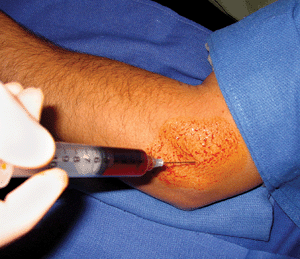One of the most confusing areas of tendinopathy rehabilitation is what to do post injection and when to do it. There are obviously loads of different injections that are popular in managing tendinopathy patients, including blood injections or PRP, steroid, high volume injections, prolotherapy, sclerosing or polidocinol, etc, etc. Many patients and clinicians have asked over the years about rehab protocols post these injections. In many cases patients may not do any rehab at all or do their rehab way too late after injection. I don’t really have set out protocols but the principles are universal, and here they are:
1) Rest from tendon loading activities until post injection flare, if any, settles. This is usually 2-5 days, depending on the injection. After PRP and sometimes prolotherapy (depending on which irritant is injected) irritation may last 2 weeks or more, so time off from loading may be longer. A caveat here is ensuring there is atleast a few days rest from tendon loading activities when there is no post injection flare, especially after steroid.
2) Start with low tendon loading activities – e.g. in the lower limb this would be non-impact cardiovascular (e.g cycling, swimming) and slow loading such as calf raises for the Achilles tendon
3) Start with concentric-eccentric loading. There are several potential reasons why this would be necessary, so it is always a good principle. Reasons are outlined here:
- Neuromuscular dysfunction post injection (eg reduced activation, inhibition) may be associated with concentric dysfunction
- Neuromuscular dysfunction post injection may mean the execution of isolated contraction is difficult initially
- These reasons are additional to the likelihood that most tendinopathy patients with a long history (ie most injection candidates) will have underlying concentric strength deficits (due to neuromuscular, structural deficits, etc) that will benefit from concentric loading
4) If indicated, progress to eccentric only loading in Achilles and maybe patellar – Isolated eccentric loading is only really evidence based and indicated in Achilles and patellar tendinopathy – indications for isolated eccentric loading probably should be the topic of a separate blog
5) Progress to high tendon loading. This includes faster tendon loading and impact or stretch-shortening cycle (SSC) loading. This can be double leg jumping, single leg hops, running, bounds, box jumps, skipping, etc, or just a walking program for non-sporting people. What is done is less important than making sure it is progressive and points 7 & 8 below are followed.
6) Make sure kinetic chain deficits at other links are addressed – can do this even whist waiting for local symptoms to settle
7) Monitor pain closely – pain psychology is the most important aspect of tendinopathy rehabilitation. Patients should be able to perform loading with tolerable symptoms, and this is actually quiet normal, ie to have some pain with loading, especially when starting a new activity such as hopping – I find making sure patients are aware of this is the most critical aspect of load progression in rehab. The key is that exercise flare settles within 24 hours
8) Clearly define criteria for progression, ie
- Concentric-eccentric to eccentric alone
= Able to execute good quality and reasonable endurance with concentric-eccentric loading (eg I use 15 single leg calf raise repetitions in the Achilles)
- Commencing fast and SSC loading
= Able to execute SSC loading with reasonable form/technique – ie no obvious aberrant biomechanical patterns. This depends on adequate underlying strength and not tolerable symptoms, and other factors
Again, how it is fleshed out is less important than the criteria themselves and making sure that patients are built up to be able to execute their sport/function progressively
For those who prefer protocols, here is a one we use post Achilles PRP at one of the centres I work at…post PRP rehab AT
Other questions such as how heavy to load, how frequently, etc, are just based on standard tendinopathy rehab principles. Our group is currently working on a review paper outlining these – hopefully coming soon!
Let me know if any feedback or questions


